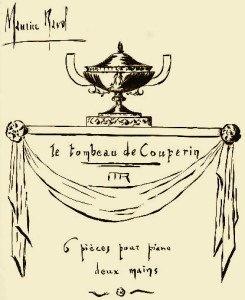Ravel: Le Tombeau de Couperin
 I began learning this piece when I was in the Army. A conductor friend of mine had developed an obsession with Maurice Ravel (1875-1937)–I don’t think that’s overstating it. He played Ravel on the piano and talked on and on about all the things he was discovering about Ravel’s music. Living in open barracks with your fellow service-members tends to reduce your tolerance for their idiosyncrasies. (Okay, this is not typical barracks talk, but it was an Army band outside Boston filled with graduates of the New England Conservatory, and yes there were times when the conversation turned to less elevated subjects.) Anyway, I could have developed a real aversion to all things Ravel. But my friend had a point, and he coached me through the portions of Le Tombeau de Couperin that were within my limited piano skills. (Quite a lot of it was not.) I decided to like Ravel and to overlook his French-ness.
I began learning this piece when I was in the Army. A conductor friend of mine had developed an obsession with Maurice Ravel (1875-1937)–I don’t think that’s overstating it. He played Ravel on the piano and talked on and on about all the things he was discovering about Ravel’s music. Living in open barracks with your fellow service-members tends to reduce your tolerance for their idiosyncrasies. (Okay, this is not typical barracks talk, but it was an Army band outside Boston filled with graduates of the New England Conservatory, and yes there were times when the conversation turned to less elevated subjects.) Anyway, I could have developed a real aversion to all things Ravel. But my friend had a point, and he coached me through the portions of Le Tombeau de Couperin that were within my limited piano skills. (Quite a lot of it was not.) I decided to like Ravel and to overlook his French-ness.
Quite a few years later, another conductor friend of mine had just finished a orchestra performance featuring Ravel’s music. Now this conductor was no fan of Impressionism, and Ravel tends to get lumped in with the Impressionists. We were discussing Ravel over dinner and he clearly had been converted into a fan. When he asked my assessment of Ravel, I simply said that Ravel is Debussy with form. “That’s it!” he said, and we didn’t need to discuss it further.
Whatever you may like about Debussy and the Impressionists (a label Debussy rejected), you will probably find that Ravel has all of that and more. He has form, which adds clarity and depth and life to his music. The form of Le Tombeau de Couperin mimics the French Baroque dance suite with short movements Prélude, Fugue, Forlane, Rigaudon, Menuet, and Toccata. Ravel later scored parts of the suite for orchestra, but I prefer the original piano version.



